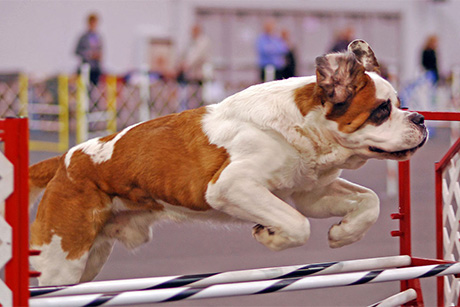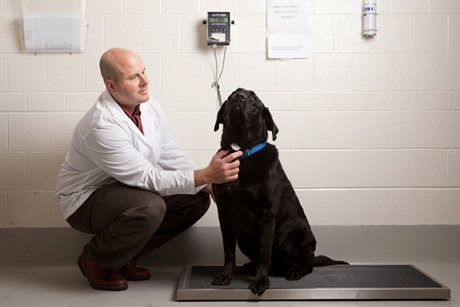New sports rehab program gets pets back in the game
By Carly Hodes


From elite champions of the sporting circuits to old dogs who enjoy casual walks, most active animals suffer setbacks at some point in their lives. Cornell University Hospital for Animals (CUHA) has initiated a new Sports and Rehabilitation Medicine service to help them return to their feet and get back in the game.
Section Chief of Clinical Nutrition Dr. Joseph Wakshlag, a member of the American College of Veterinary Sports Medicine and Rehabilitation, will direct the program. Specializing in rehabilitation, the service will treat canine athletes as well as companion animals recovering from injuries or experiencing orthopedic or neurologic problems, including cats. The service focuses on helping animals recover performance abilities and stay active at any age.
“Recovery is not just about surgery, physical therapy, general health care or nutrition – it’s about all these things working together,” said Wakshlag. “Just like in human medicine, sports medicine for animals is an interdisciplinary field that integrates several modalities to help patients in ways one specific service can’t. Sports medicine offers an extra level of expertise that typically can’t be found in most general veterinary practitioners’ offices.”
From racing greyhounds, sled dogs and hunting dogs to dogs trained in agility, jumping and field trials, an increasing number of dogs train and compete in canine sports. While sports medicine is common in the human and equine worlds, few clinics offer such services for dogs. Since launching this spring, CUHA’s Sports and Rehabilitation Medicine program has seen around five to 10 patients per week.
The program offers shockwave ultrasound for orthopedic conditions, therapeutic ultrasound for deep tissue heating, transcutaneous electrical nerve stimulation, underwater treadmill, low-level light laser therapy for wound healing and chronic pain, and electrical acupuncture. A force plate, which measures how well an animal uses a limb, can validate whether and to what extent a treatment works.
Pioneering the next generation of treatments, Wakshlag is examining tissue-healing platelet-rich plasma therapy, which has revived the prowess of many amateur athletes as well as sports stars such as Tiger Woods and Kobe Bryant and many racehorses. He is also involved in studies to determine whether and how supplements enhance performance and how diet can influence recovery.
“Sports medicine is getting more popular, and if we want to learn what works and how, we have to do research,” said Wakshlag. “That’s part of our duty and mission in academia, to advance the field and our understanding of it.”
Beyond research, the program opens opportunities for students to learn lesser-known treatments including techniques used by human physical therapists. Wakshlag will introduce basic rehabilitation lectures into the veterinary curricula, and students serving in the orthopedics and neurology rotations may spend time with the new program’s patients.
The program also opens a new residency in Sports and Rehabilitation Medicine, which Dr. Chris Frye ’11 will complete as part of a dual residency along with nutrition over the next five years. The new residency is funded in part by a gift of $120,000 from Nestle Purina, which has provided $1.7 million over the past 10 years to support various college initiatives related to improving companion animal well-being.
To make an appointment with the Sports and Rehabilitation Medicine program, contact CUHA at 607-253-3060 or vet-hosp@cornell.edu.
Carly Hodes ’10, MBA ’15, is a communications specialist at the College of Veterinary Medicine.
Media Contact
Get Cornell news delivered right to your inbox.
Subscribe